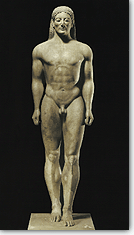







     | |
  |
|
|
|
Almost every great work of Archaic sculpture was made to meet the needs of worship or more generally the spiritual needs of the people. However, elements of a secular nature often intruded, such as the signatures on the sculptures, the tomb inscriptions and the name of the dedicator. The development of great sculture and plastic art in the Archaic period is partly owed to the progress of the metal processing techniques, as, for example, hammering and casting. The latter has been attributed, since antiquity, to the Samian artists Rhoikos and Theodorus, but the only certain fact is the important role of Samian workshop in the principles of bronze sculpture. On the contrary, sculpture in stone or marble was initially developed in Crete, acquiring a particular characteristic known as Daedalic style. Later, two basic sculptural types were developed: the kouros and the kore. These types appear almost as a continuation of Daedalic forms and their development leads to severe style sculpture. There were many local workshops from Ionia to western Greece. Architectural sculpture also developed significally, since the construction of large stone temples allowed their decoration with sculptures comparible in size. Finally, funeral plastic was often inspired by the forms of animals and monsters. |  |
|
| |
|
Note: Click on picture for short description. | |